History
- TCS is a rare hereditary disease characterized by underdeveloped cheekbones and jawbones;
- The disorder was named after a British Ophthalmologist, Dr. Treacher Collins;
- TCS was misunderstood prior to the 1800s;
- It was not until the 1800s that research into the disorder was conducted;
- Treacher Collins’ research helped in understanding TCS;
- The genetic connections of TCS was identified in the late 1990s;
- TCS is characterized by underdeveloped craniofacial features.
Treacher Collins syndrome (TSC) also referred to as Collins-Franceschetti syndrome or Mandibulofacial dysostosis is a rare hereditary disease where by the cheekbones and jawbones are underdeveloped.
The disorder was named after a British Ophthalmologist, Dr. Treacher Collins after he discovered it in two children. This disorder is diagnosed in children who have malformed ears, underdeveloped cheekbones and eye sockets, sparse eyelashes and a small and slanting lower jaw.
TSC was primarily misunderstood until the late 1800s that the connection between parent and child was discovered. Edward Treacher Collins was the main historic figure bringing this understanding to science.
It was not until the 1800s that research into the conditions and reasons for the genetic disorder were fully conducted.
Treacher Collins’ research single-handedly changed the history of Treacher Collins syndrome, giving the medical world the principles that helped science understand the full dynamics of the genetic disorder.
The modern understanding of the genetic connections of Treacher Collins syndrome was identified in the late 1990s as part of the Human Genome Project. Scientists now fully understood how the dominant gene was transferred to children and what mutations were prevalent on chromosome 5. It was also found that some children were spontaneously afflicted with the disorder through new mutations as well.
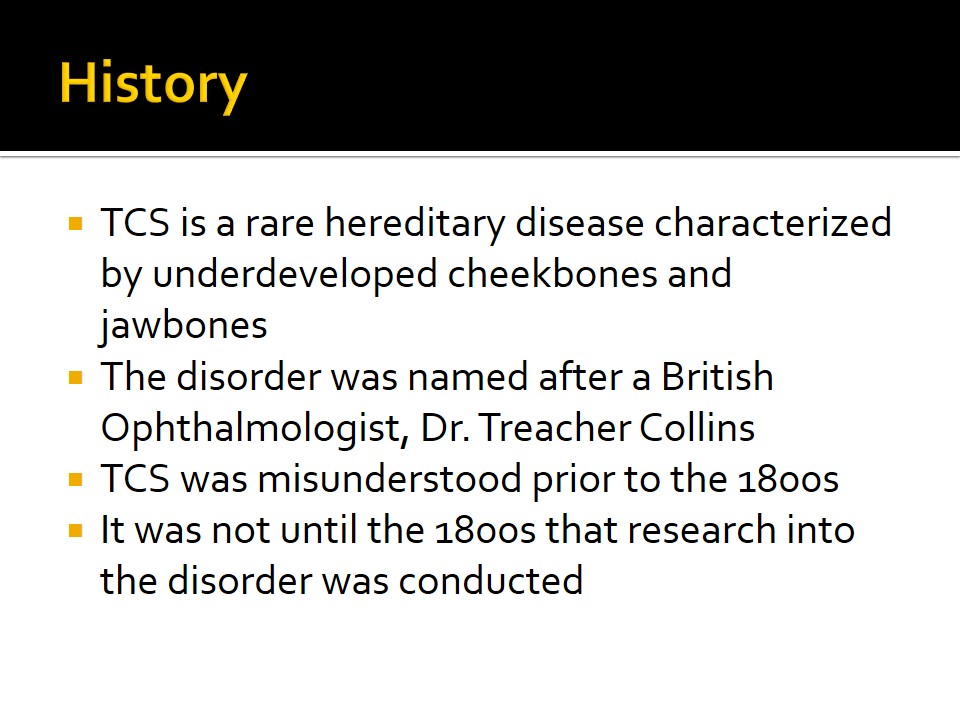
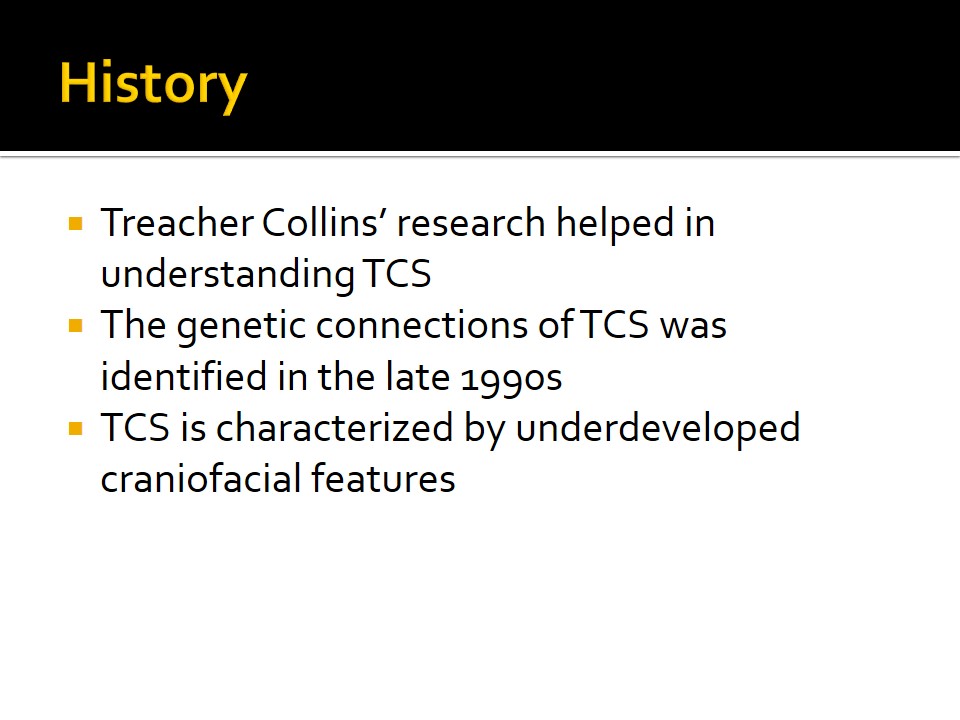
Etiology and the Parts of the Body that are Affected
- TCS results from a mutation of the TCOF1 gene.
- The gene located on chromosome 5.
- This gene controls development of the bones and other structures of the head and neck.
- This condition is dominantly inherited.
- The mutation prevents facial bones from developing as they should in the womb.
- The disorder prevents the skull, cheek and jawbones from developing properly.
- These abnormalities often cause problems with hearing, breathing and eating.
- The disease mainly affects the facial areas.
Treacher-Collins Syndrome results from a mutation of the TCOF1 gene (Treacher Collins-Franceschetti Syndrome 1).
The gene located on chromosome 5.
This gene controls development of the bones and other structures of the head and neck.
This condition is dominantly inherited.
When the gene is faulty, the facial bones do not develop as they should in the womb and a baby is born with characteristic facial features
As a result, the disorder prevents the skull, cheek and jawbones from developing properly, causing facial defects and hearing loss.
The extent of these abnormalities varies from person to person, but they often cause problems with hearing, breathing and eating.
The disease mainly affects the facial areas. Consequently, the ears, nose mouth, and eyes are all affected.
The disorder also affects the airway, the dental system, and generally leads to facial deformity.
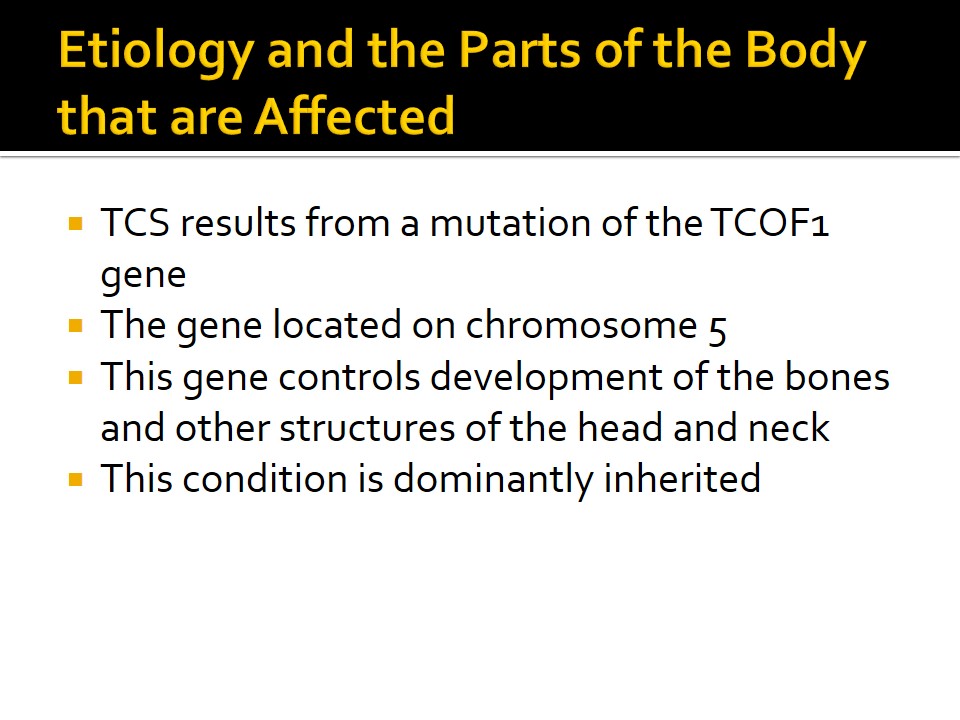
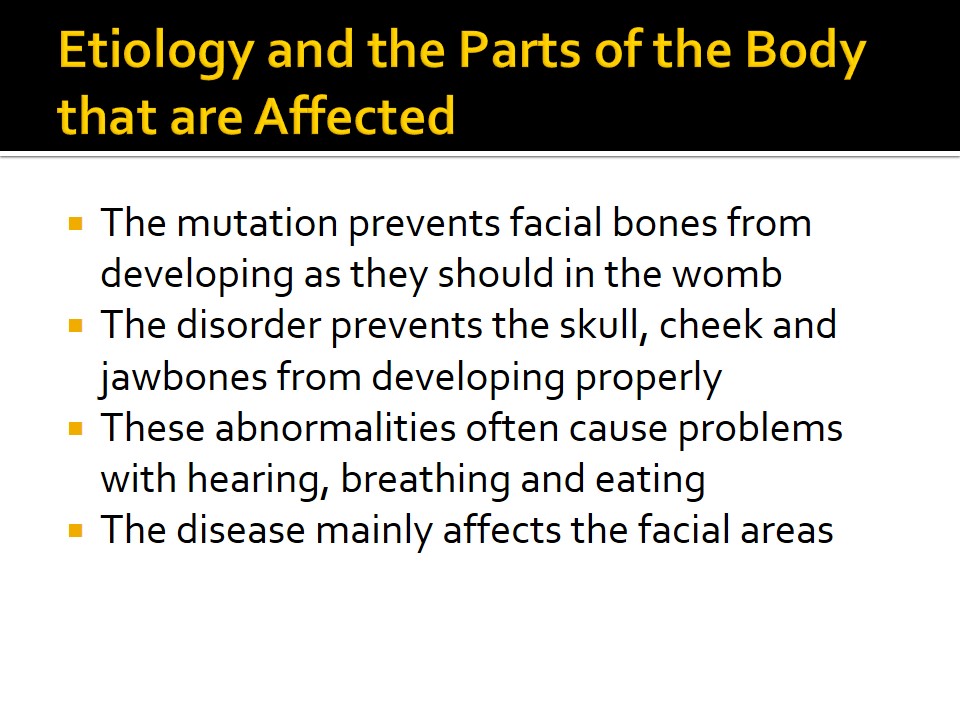
Parts of the Body that are Affected
- Consequently, the ears, nose mouth, and eyes are all affected.
- TCS also affects the airway and the dental system.
- TCS generally leads to facial deformity.
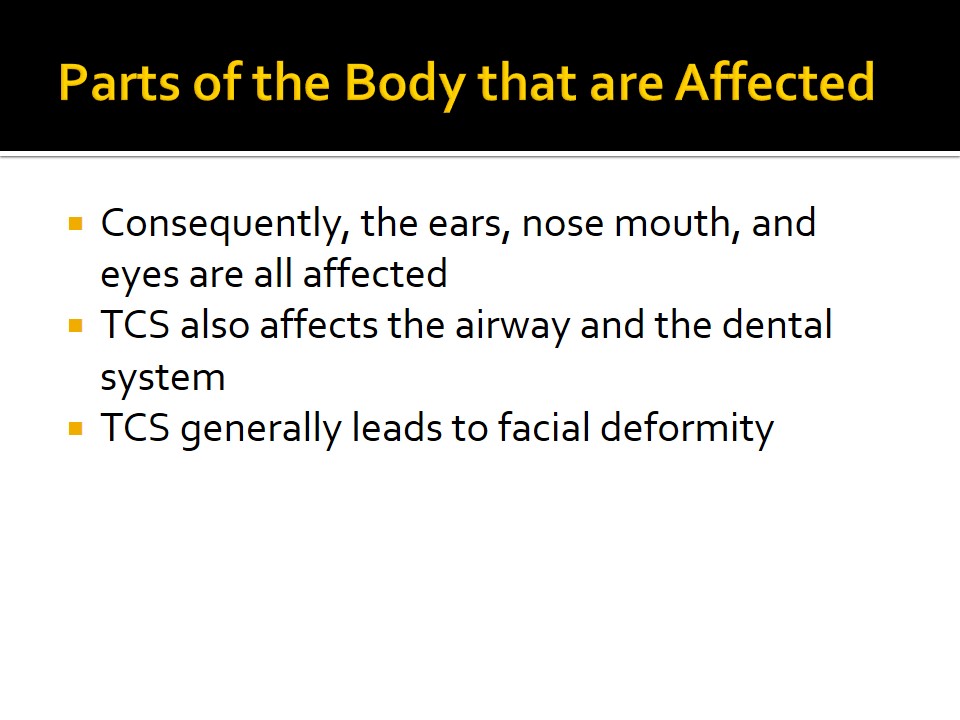
Prevalence and incidence
- TCS is listed as a rare disease in the US.
- Hence, it affects less than 200,000 people in the entire US population.
- It affects approx. 1 in 50,000 persons in the US.
- Incidence is estimated between 1-40,000 to 1-70,000 of all live births.
- TCS occurs in one of 10,000 births among affected parent(s).
- For unaffected parents with one affected child, the chance of giving birth to a second child with TCS is negligible.
- Adults with TCS have a 50% chance of passing the condition to their offspring.
Treacher-Collins Syndrome is listed as a “rare disease” by the Office of Rare Diseases (ORD) of the National Institutes of Health (NIH). This means that the disorder affects less than 200,000 people in the US population.
Approximately 1 in 50,000 or 0.00% or 5,440 people in USA.
Incidence is estimated to range between 1-40,000 to 1-70,000 of live births.
It is estimated that this disorder occurs in one of 10,000 births among affected parents. For unaffected parents with one child with this disorder, the chance of giving birth to a second child with this condition is negligible.
Adults with this disorder have 50% chance of passing the condition to their offspring. When a parent with this disorder passes on the genes, the children maybe affected in varying degrees. The degree maybe the same as the parent, milder, or more severe.
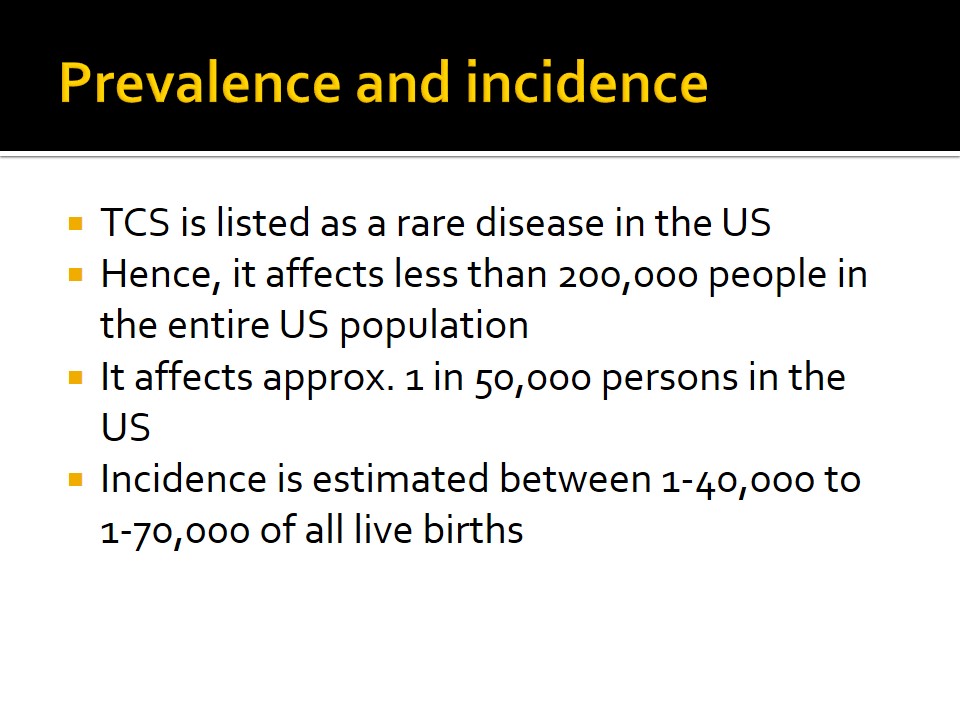
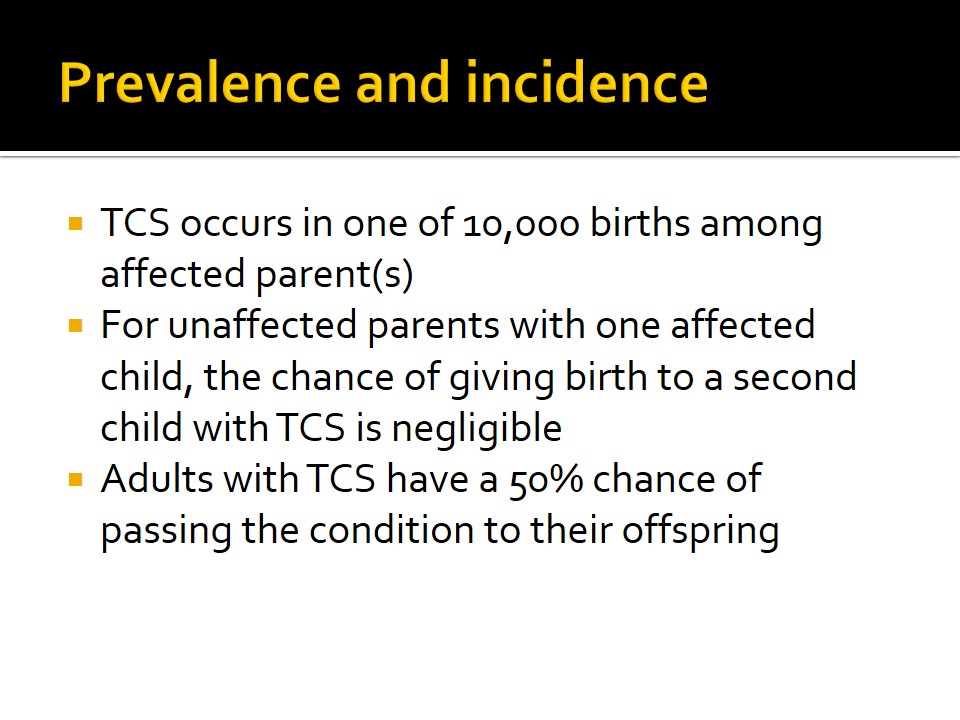
Symptoms
- Outer part of the ears are abnormally shaped.
- Hearing loss (Marszalek, pp. 550).
- Small or obstructed nasal passage.
- A small lower jaw which may slant in some cases.
- An unusually large mouth.
- Defects in the eye that extend into the lower lid.
- An unusual hairline.
- Decreased eyelashes on the lower eyelid.
- Underdeveloped or missing cheekbones.
- Clefts in the face.
Outer part of the ears are abnormal or almost completely missing.
Hearing loss due to dysmorphicism of the middle ear cavity or absence of the ossicles and hypoplasia of the middle ear cavities.
Small or obstructed nasal passages due to the abnormal development of mandibular bones.
A small lower jaw, which may slant in some cases. This results from the underdevelopment of mandibular bones.
An unusually large mouth due to the abnormal development of mandibular bones.
Defects in the eye that extend into the lower lid.
An unusual hairline, with hair growing across the cheek like a sideburn.
Decreased eyelashes on the lower eyelid.
Underdeveloped or missing cheekbones and side wall/floor of the eye socket.
Clefts in the face due to the abnormal development of mandibular bones.
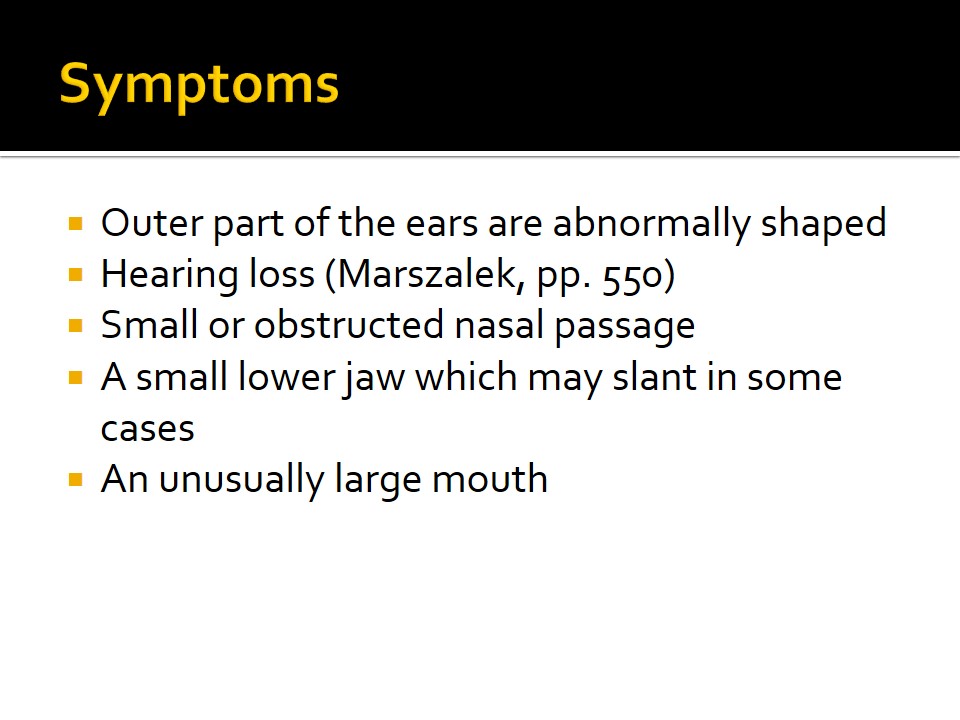
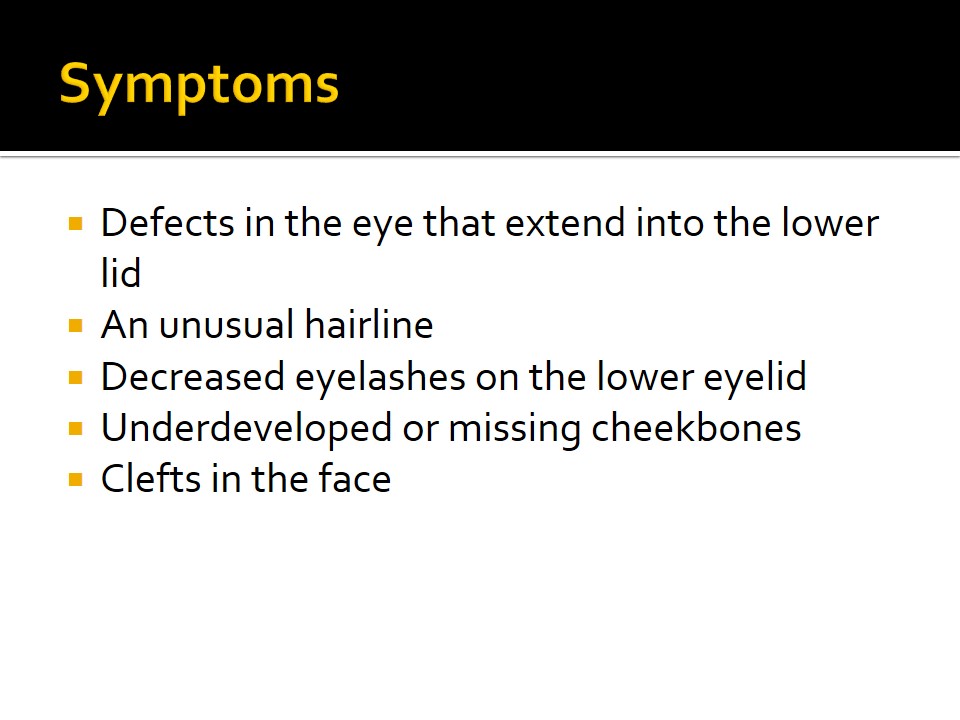
The Disease Process
- TCS results from a mutation of the TCOF1 gene.
- The TCOF1 gene facilitates the manufacture of Treacle.
- Treacle is important in the development of facial bones and related structures.
- Treacle is thought to be involved in the production of rRNA within cells.
- Mutations in TCOF1 cause haploinsufficiency of Treacle.
- This causes a depletion of the neural crest cell precursor.
- The crest cells are vital towards the development of the craniofacial appearance.
- Haploinsufficiency of Treacle affects the development of several craniofacial features.
Treacher-Collins Syndrome results from a mutation of the TCOF1 gene.
The TCOF1 gene provides instructions for making a protein called treacle. This protein is active during early embryonic development in structures that become bones and other tissues in the face. Treacle plays a critical role in the development of facial bones and related structures.
Treacle is thought to be involved in the production of a molecule called ribosomal RNA (rRNA) within cells. Ribosomal RNA, a chemical cousin of DNA, helps assemble protein building blocks (amino acids) into functioning proteins. Treacle is active in the nucleolus, which is a small region inside the nucleus where rRNA is produced.
Mutations in TCOF1 cause haploinsufficiency of Treacle. This causes a depletion of the neural crest cell precursor, which leads to a reduced number of crest cells migrating to the first and second pharyngeal arches. These crest cells are vital towards the development of the craniofacial appearance.
This affects the development of several craniofacial features.
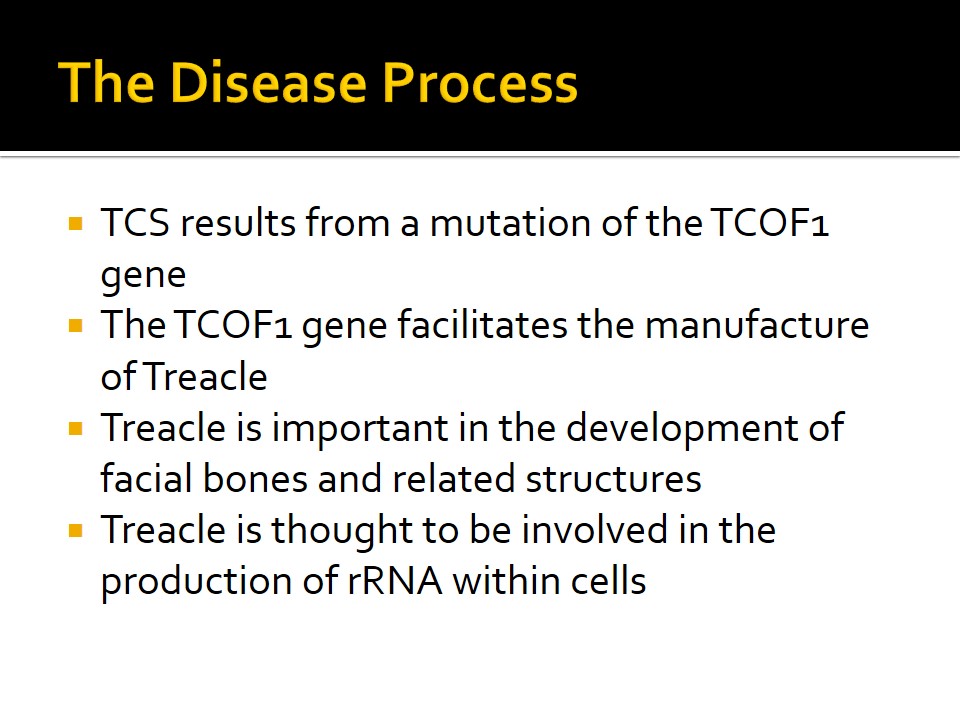
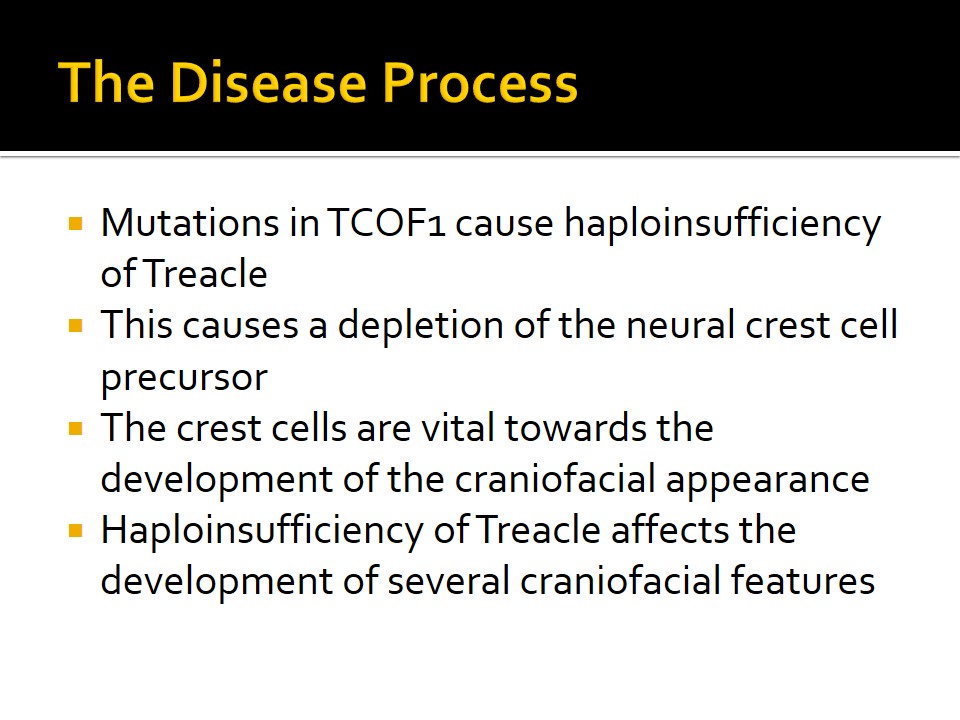
Diagnostic Tests
- TCS can be diagnosed before birth through ultrasound.
- After birth, physical examination and medical history can be used to diagnose TCS.
- Physical examination entails inspecting the zygomatic bones and mandibles and checking for external ear and lower eyelid abnormalities.
- Presence of TCS is shown by midface hypoplasia with a bilaterally symmetric convex facial profile, prominent nose, and characteristic downward slant of the eyes secondary to hypoplasia of the lateral aspects of the orbits.
- Further examination of the eyelid and external ear are undertaken.
- For an infant, the external ear shows a number of deformities, including absent, small, and malformed ears.
- Presence of TCS is shown by a number of craniofacial deformities.
- Physical examination is followed by X-rays or CT scans.
- The results may be confirmed using the family and medical history.
- Genetic testing is sometimes used.
Treacher Collins syndrome can be diagnosed before a baby is born because the abnormal facial features are visible during an ultrasound.
Tests used to diagnose Treacher Collins syndrome may include physical examination and medical history.
Physical examination includes taking a closer look at the zygomatic bones and mandible and checking for external ear abnormalities and lower eyelid abnormalities.
Presence of TCS is shown by midface hypoplasia with a bilaterally symmetric convex facial profile, prominent nose, and characteristic downward slant of the eyes secondary to hypoplasia of the lateral aspects of the orbits. Besides, micrognathia and retrognathia with variable effects on the temporomandibular joints and jaw muscles are observed in an examination of the zygomatic bones and mandible.
For a child or infant with TCS, an examination of the external ear shows a number of deformities, including absent, small, and malformed ears (microtia) or rotated ears.
Examination of the eyelid also shows a number of abnormalities including coloboma (notching) and sparse, partially absent, or totally absent lashes.
Physical examination is followed by X-rays or CT scans to confirm the findings in the physical examination process.
A family and medical history consistent with autosomal dominant inheritance also shows a likelihood of having TCS.
Genetic testing is sometimes used but this is often not necessary as the diagnosis can be made easily on clinical features alone.
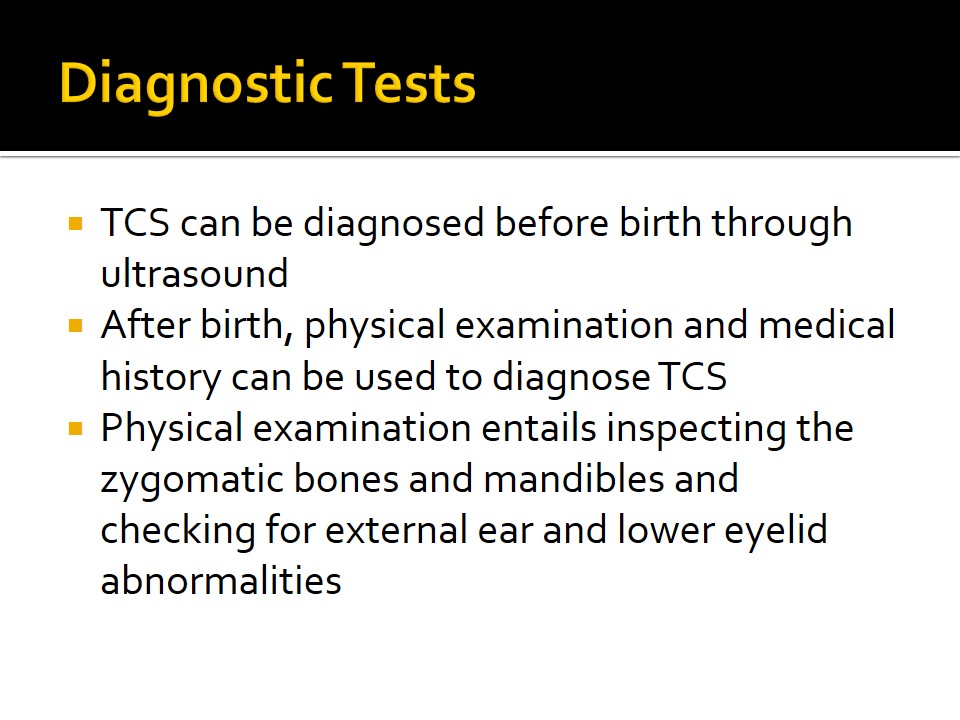
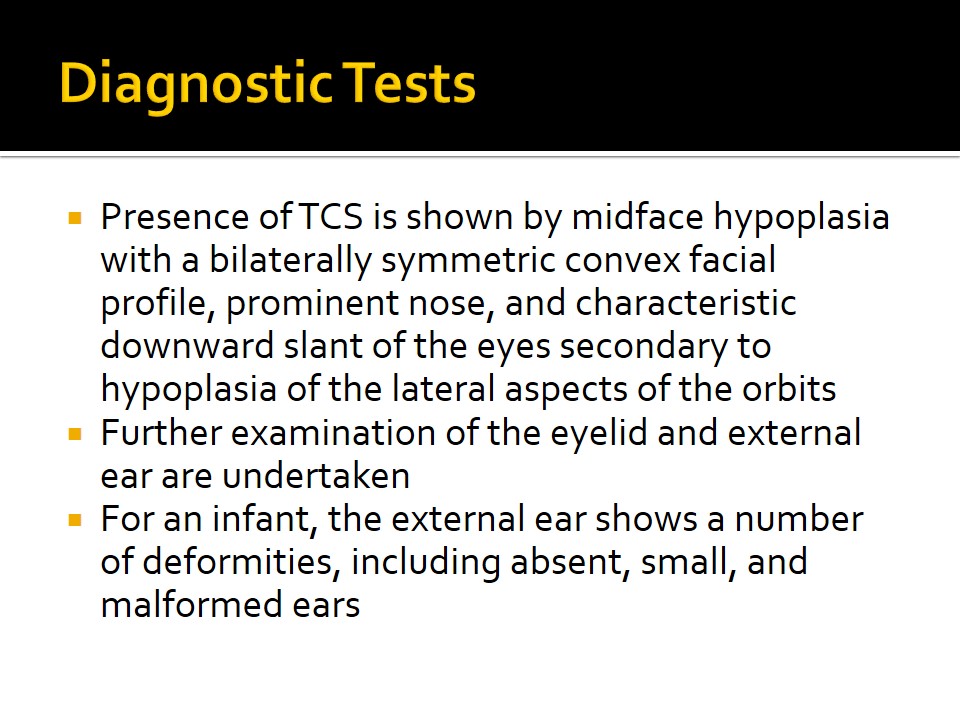
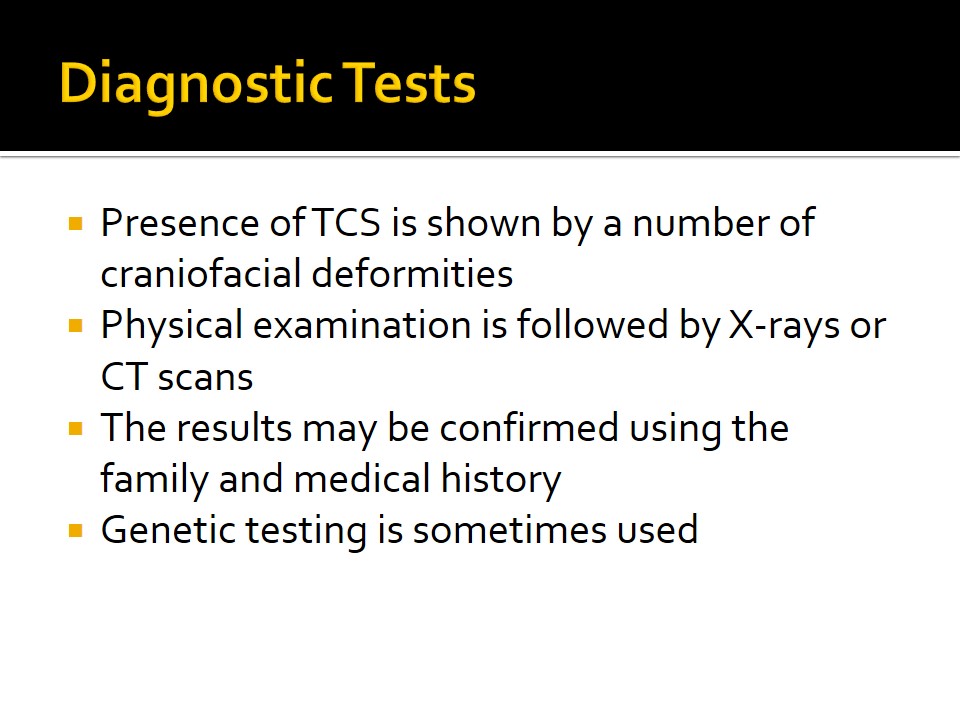
Prognosis of TCS
- Prognosis of the TCS should be encouraged.
- A tracheostomy may be needed to help breathing.
- Reconstructive surgery may help to build up cheekbones.
- Overcrowded teeth may require dental work.
- Hearing loss is treated to ensure better performance in school.
- The child may require plastic surgery occasionally.
- Children with this syndrome typically grow to become normally functioning adults of normal intelligence.
Prognosis of the TCS should be encouraged. It can help patients take appropriate measures against the side effects of the symptoms. For example, hearing loss can be countered by wearing or implanting hearing aids.
A tracheostomy (a hole into the trachea through the front of the neck) may be needed to help breathing, while reconstructive surgery may be necessary to correct a cleft palate.
Reconstructive surgery may also be offered to build up the cheekbones, correct the nose or an underdeveloped jaw (which may help to improve breathing) or reconstruct the outer ear.
Overcrowded teeth or malocclusion of the bite (where teeth do not meet each other as they should) may require dental work.
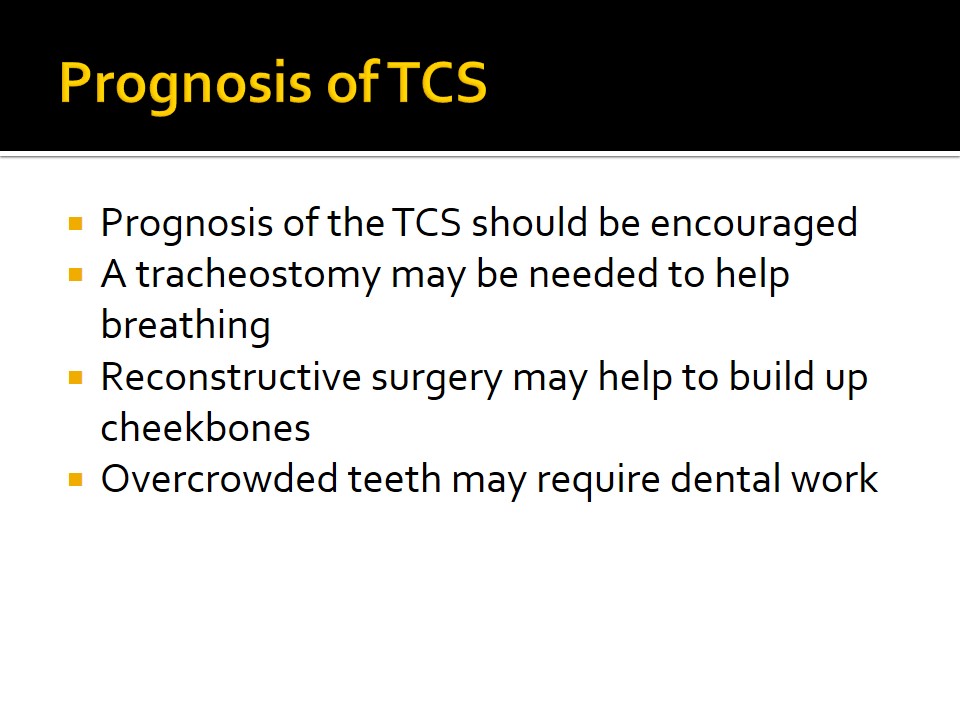
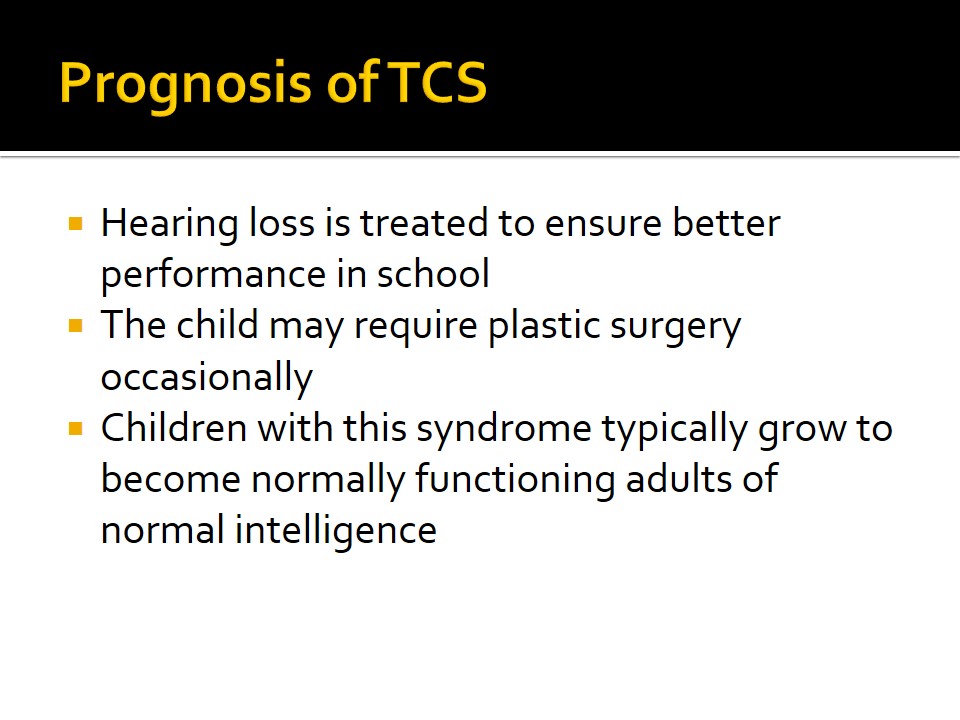
Work Cited
Marszalek, Bozena, et al. Clinical features, treatment and genetic background of Treacher Collins syndrome, Annals ofPlastic Surgery, 56, 2006. 549-554.